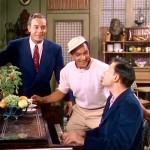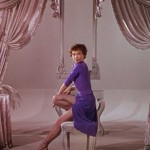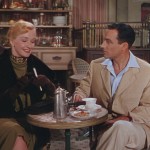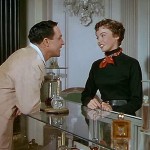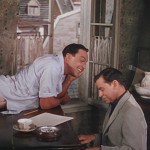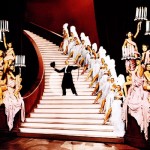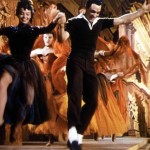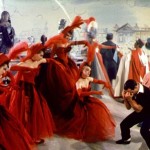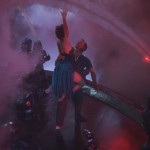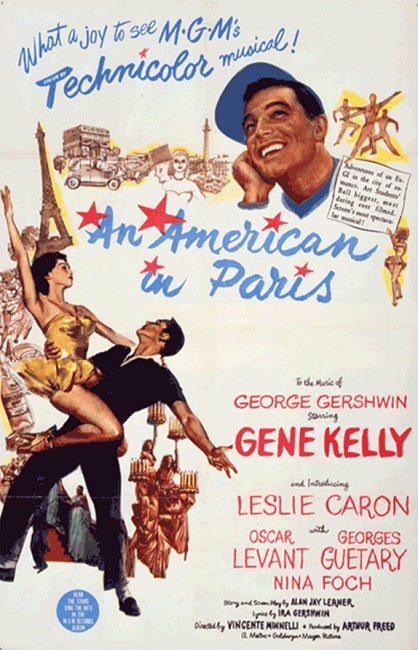
An American in Paris – 1951
Yay!! Color!! Gone With the Wind won the Best Picture Award in 1939 – twelve years earlier. It was the first winner that was filmed in Technicolor. After that we went directly back in to black and white. What is taking movie makers so long to start making color films on a regular basis? Was it really that much more expensive, unwanted, or difficult to produce color movies? An American in Paris finally stepped up to the plate. That being said, I found it ironic that in the wild party scene before the big ballet sequence, the party-goers were all dressed in costumes that were completely black and white.
Yes, I said ballet. This movie was a musical, but not just a musical. It was a dance-musical. This is the first time I have watched it, and I have to admit that I went into it thinking that the plot would be practically non-existent. I thought that the movie would be nothing more than an excuse for Gene Kelly to show off his skills as a dancer and choreographer. But after watching the movie, I was pleasantly surprised. I mean, sure, Kelly got to show off a lot, but the story was a little deeper than I expected… but only a little.
The plot revolves around three men and two women. Gene Kelly plays Jerry Mulligan, the painter who is in love with Lise Bouvier , played by Leslie Caron. Georges Guetary plays Henri “Hank” Baurel, the singer who is also in love with Lise. Nina Foch plays Milo Roberts, the rich heiress who is in love with Jerry. And finally, Oscar Levant plays Adam Cook, the concert pianist who is in love with himself. Throw them all together and you get a light-hearted plot that thankfully doesn’t try to take itself too seriously. Because we all know why we are really here: To hear the music of George and Ira Gershwin and to see Gene Kelly dance to it.
And we really do get what we came for. Kelly’s dancing is incredible! He was young, fit, and very attractive. His dance moves were performed with a grace and ease that made them seem like they were effortless, like the practiced and complex steps were second nature to him. And his choreography was so appropriate to Gershiwn’s music. The musical styles that were represented ranged from classical to ballet, from jazz to show-tune, with maybe even touches of big-band and Vaudeville. Kelly’s dance moves kept pace, showing off his incredible talent and an obvious love for the art form. And who knew you could tap-dance in loafers?
Interesting note: Gene Kelly received an Academy Honorary Award that year for “his versatility as an actor, singer, director and dancer, and specifically for his brilliant achievements in the art of choreography on film.” It was his only Oscar.
Leslie Caron was able to keep pace with Kelly quite well, though to be honest, it sometimes didn’t appear as effortless for her as it was for him. Every now and then, she looked as if she really had to concentrate on what she was doing. Then again, she did much of her work in toe-shoes, standing, walking, spinning, and leaping on the tips of her toes. Not being a dancer, myself, I can only imagine how difficult that kind of dancing is. But she did it all with a big brilliant smile.
Really, Kelly and Caron were the only members of the main cast who did any dancing. Guteary was cast for his voice, and did a fine job, especially in his big number, I’ll Build a Stairway to Paradise. If I had any complaint about his character, it would be that he had a very strong French accent. Appropriate for a movie set in France, but sometimes, the accent was so thick that you couldn’t understand what he was saying, and for a song sung in English, that would seem to be a necessity. Foch neither sang nor danced, but she was gorgeous, and she played the part of the spoiled rich girl well.
Finally we come to Oscar Levant. Goodness gracious! He was incredible. As I have mentioned before in an earlier review, I can always tell if someone in a movie is actually playing their instrument, or if he is just pretending. There is no doubt – Levant was really as talented as his character was supposed to be. His piano playing was spell-binding. He was amazing and flawless. There is a scene in which he plays Gershwin’s Concerto in F for Piano and Orchestra. I was riveted as I watch his fingers fly over the keyboard. True, the scene itself was obviously gratuitous, not at all necessary to the plot in any way, but the performance was so incredible, I didn’t mind.
And the same could be said for a lot of dancing in the film. Sometimes it came out of nowhere, and it almost felt like it was there despite the story, of which, I admit, there wasn’t a lot. But the dancing was so good, it didn’t matter that it wasn’t always necessary. And as for the plot, it had its moments that caught my interest. There was one scene in particular that was cute and clever. At one point, Jerry is at a café with Henri and Adam. Henri tells his friends of the girl he loves, and how he will marry her. Jerry tells them of his girlfriend, and how he wants to do the same. Neither of them realize that they are talking about the same girl, but Adam does. Then the scene moves into the great song S Wonderful. It was a very clever little moment.
There were a few other great Gershwin tunes that were used, such as Embraceable You, Nice Work If You Can Get It, and I Got Rhythm. But then again, Gershwin’s music is always great to listen to. The movie’s big finish was the American in Paris Ballet sequence. It was sixteen minutes long and cost an unbelievable $500,000 to film. Gershwin’s symphonic tone poem, An American in Paris, was written in 1928 and remains one of his most popular works, probably second to his most famous work, Rhapsody in Blue. His music has a staggering complexity about it, but despite that fact, it has a way of remaining accessible to the listener. It is incredibly impressive, but at the same time, it sounds right in the ear.
The film was nominated for eight Academy Awards, and won six of them, but nobody expected it to take home the coveted Best Picture Award. It wasn’t the favorite, as it was up against Decision before Dawn, A Place in the Sun, Quo Vadis, and most notably, A Streetcar Named Desire. Stiff competition, to be sure, but apparently the voters were ready for something more light-hearted and fun.
Interesting note: This is just an odd little observation, I noticed. The 1951 movie poster for An American in Paris shows Leslie Caron in a yellow tutu and toe-shoes, dancing with Gene Kelly, wearing black pants and shirt. That particular tutu Caron is wearing was blue in the film and she never danced with Kelly while wearing it.
Another interesting note: I found a tiny inconsistency in the film. At one point, during the song Tra-la-la (This Time It’s Really Love), Gene Kelly is lying on top of a piano and playing notes on the keyboard, thus playing the keys backwards. But they messed up. When he played notes higher on the keys, the notes you hear were lower, and when he played notes lower on the keys, the notes you hear were higher. Kelly apparently forgot he was playing from the opposite side of the piano.
